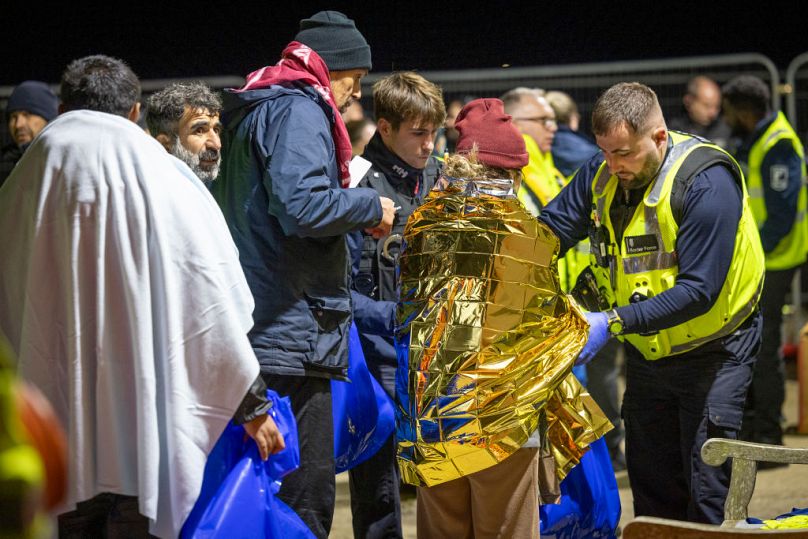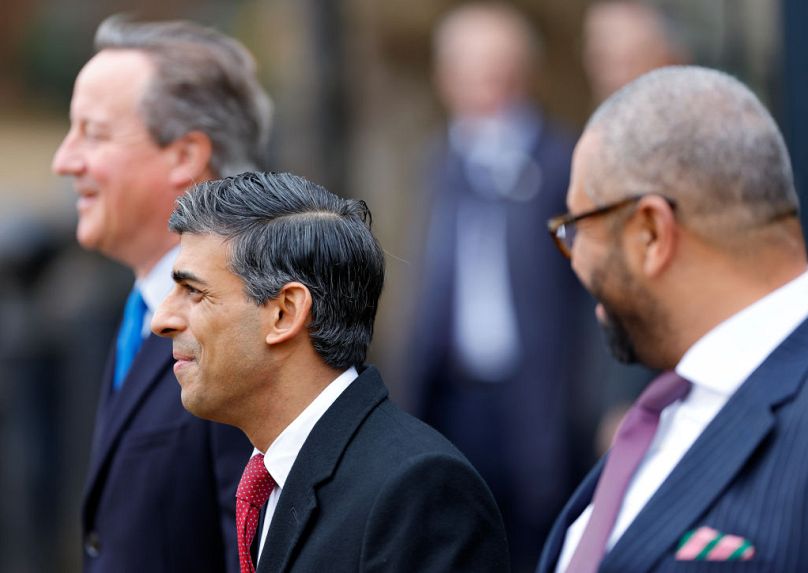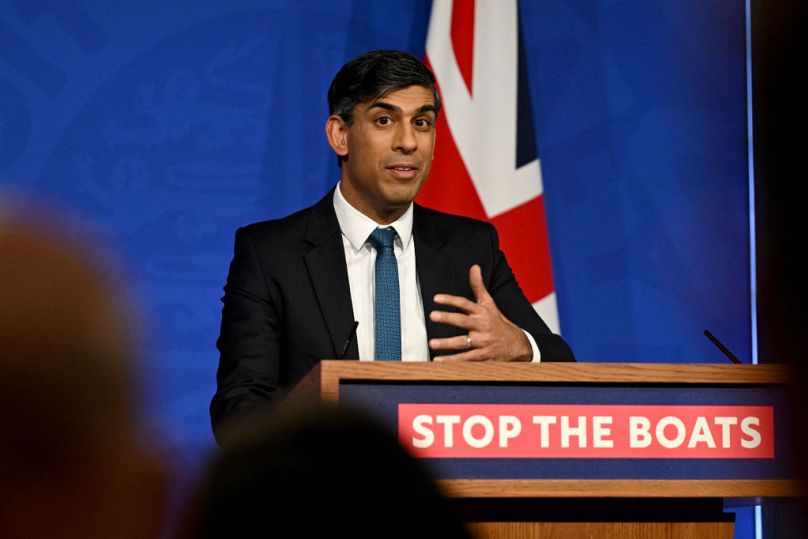The figures will likely be an embarrassment for Rishi Sunak's Conservative government who consistently pledge to bring the levels down.
Net migration in the United Kingdom hit a record-breaking 745,000 in 2022, according to revised figures which also revealed some 672,000 people came to the UK in the 12 months to June 2023.
The numbers released by the Office for National Statistics (ONS) had previously been put at 606,000, which was deemed then to be a record high.
It’s a significant embarrassment for the country’s Conservative government, who have continuously insisted that it remains committed to reducing migration.
Led by Rishi Sunak, the party has already introduced measures to try to reduce the figure.
Among their initiatives was a plan to stop international students bringing their families with them when they study in the UK - except under very specific circumstances.
Even more controversially, Sunak’s plan to send asylum seekers to Rwanda was ruled unlawful by the Supreme Court earlier in November.
It was part of his attempt to stop small boats crossing the English Channel and a policy supported by many, including the New Conservatives group on the right of the party.
They have repeatedly called for ministers to close temporary visa schemes for care workers and to cap the number of refugees resettling in the UK at 20,000 - with the aim of reducing net migration to 226,000 by the time of the election, which is likely to be held next year.
It is now certain that these efforts have not come to fruition for the Conservatives as they had hoped.
The ONS release of the statistic - some 140,000 higher than first thought - has caused criticism from all parts of the political spectrum.
The Conservatives themselves have hit out at the numbers - with former cabinet minister Simon Clarke saying having legal migration at such a level was “unsustainable both economically and socially”.
MP Jonathan Gullis went one step further, calling the figures "completely unacceptable to the majority of the British people", and suggesting that "drastic action" is needed.
The newly-installed Home Secretary James Cleverly has all but dismissed the figures - and the impact they're likely to have - instead insisting that the government remained "completely committed to reducing levels of legal migration” and would also be "focusing relentlessly" on tackling illegal migration.
On the other side of the political fence, the Labour Party have been using the findings as a way to attack the Conservatives and their apparent failures.
Labour's shadow home secretary, Yvette Cooper, says she and the party believe the statistics show "the scale of utter Tory failure on immigration, asylum, and the economy".
It’s an interesting time for Sunak’s government - and its newest, surprise hire David Cameron.
In 2010, the then-prime minister - who is now Foreign Secretary Lord Cameron - pledged to bring net migration down to the "tens of thousands".
Successive Tory governments have sought to move away from exact targets for reasons exactly like we are seeing now.
Sunak is under increasing pressure from the right of his party to reduce net migration, especially in light of the 2019 Tory manifesto - when Boris Johnson was in charge. It promised to bring the "overall number down".
Home Secretary James Cleverly insists that he and the cabinet are "working across government on further measures to prevent exploitation and manipulation of our visa system, including clamping down on those that take advantage of the flexibility of the immigration system".
Do the figures work both ways?
According to the ONS, most people arriving in the UK in the year to June 2023 were non-EU nationals.
They made up a total of 968,000 immigrants, followed by 129,000 EU citizens.
At the same time, both EU nationals and Britons were leaving the country in greater numbers.
Some 10,000 more EU nationals left than arrived in the UK and 86,000 more British nationals were seen to be leaving than arriving.
The net figure for non-EU people overall, though, was 768,000 more arriving than leaving.
Work was discovered to be the largest reason people from outside the EU migrated to the UK.
That figure was at 278,000 - and the first time employment was the most popular reason.
Against the Conservatives’ wishes, more foreign students were seen to be staying for longer - and bringing dependents or family members with them.
For those coming to the UK out of desperation, the number remained relatively stable.
Around 88,000 people were granted asylum, up from 73,000 in the year to June 2022 - when ongoing COVID-19 restrictions were still having more of an impact.
The ONS suggests that net migration has "increased sharply" since 2021 due to a rise in immigration from non-EU countries.
They include thousands of individuals arriving via humanitarian routes from the likes of Ukraine and Hong Kong.
The ONS figures show that the asylum backlog has fallen slightly.
At the end of June 2023, there were 175,457 people waiting for a decision on their asylum claim; that number dropped to 165,411 by the end of September.
But, that’s not as positive as it might seem, Sile Reynolds, Head of Asylum Advocacy at Freedom from Torture tells Euronews.
“The UK Government’s own data on asylum disproves the toxic and divisive narrative that has guided its punitive approach to refugees. These statistics leave no doubt that most people reaching our shores need sanctuary – men, women and children who have fled the most unimaginable horrors like torture and war, in places like Afghanistan, Syria and Iran,” Reynolds explains.
The charity also hit out at the government's treatment of so-called “legacy backlog” cases.
They are, in simple terms, claims made before the end of June 2022, which are being cleared by the Conservatives at significant speed, with 28,202 cases taken care of in the last three months.
“The phenomenal rate at which ‘legacy’ claims are being decided – at nearly 8,000 per month – demonstrates what they can do when they want to deal with a problem”, Reynolds tells Euronews.
“This data disguises the catastrophic backlog of new asylum claims growing as a direct result of a flawed policy of deterrence. As a result, thousands of refugees, including survivors of torture, are condemned to languish in limbo and unsafe accommodation, unable to recover or rebuild their lives,” he adds.
All change for asylum rules?
Sunak’s Rwanda policy was targeted at people arriving in the UK by ‘unauthorised means’, including frequent Channel crossings.
They would have been deported to the African nation and made to claim asylum there and not in the UK.
In its landmark ruling, though, the Supreme Court said that those sent to Rwanda would be at "real risk" of being sent back to their country of origin regardless of whether their asylum claim was justified or not.
That, they say, is something which would breach international laws on human rights.
Sunak called the ruling “frustrating” and promised to double down on the policy, saying he would "change laws and revisit... international relationships".
That is not a popular plan with many.
“These statistics show that cruel deterrents, like the Rwanda plan so recently declared unlawful by the highest court in the land, will not stop people risking their lives trying to reach sanctuary here in the UK,” Reynolds says, adding, “Rather than punishing refugees, this Government should reverse the cruel asylum ban, urgently refocus their efforts into rebuilding a fair and compassionate asylum system and restore and expand safe routes to protection.”














